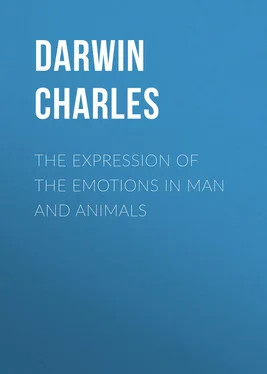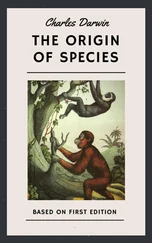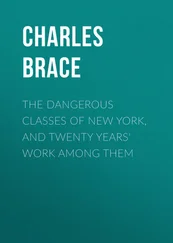Charles Darwin - The Expression of the Emotions in Man and Animals
Здесь есть возможность читать онлайн «Charles Darwin - The Expression of the Emotions in Man and Animals» — ознакомительный отрывок электронной книги совершенно бесплатно, а после прочтения отрывка купить полную версию. В некоторых случаях можно слушать аудио, скачать через торрент в формате fb2 и присутствует краткое содержание. Жанр: foreign_antique, foreign_prose, на английском языке. Описание произведения, (предисловие) а так же отзывы посетителей доступны на портале библиотеки ЛибКат.
- Название:The Expression of the Emotions in Man and Animals
- Автор:
- Жанр:
- Год:неизвестен
- ISBN:нет данных
- Рейтинг книги:3 / 5. Голосов: 1
-
Избранное:Добавить в избранное
- Отзывы:
-
Ваша оценка:
- 60
- 1
- 2
- 3
- 4
- 5
The Expression of the Emotions in Man and Animals: краткое содержание, описание и аннотация
Предлагаем к чтению аннотацию, описание, краткое содержание или предисловие (зависит от того, что написал сам автор книги «The Expression of the Emotions in Man and Animals»). Если вы не нашли необходимую информацию о книге — напишите в комментариях, мы постараемся отыскать её.
The Expression of the Emotions in Man and Animals — читать онлайн ознакомительный отрывок
Ниже представлен текст книги, разбитый по страницам. Система сохранения места последней прочитанной страницы, позволяет с удобством читать онлайн бесплатно книгу «The Expression of the Emotions in Man and Animals», без необходимости каждый раз заново искать на чём Вы остановились. Поставьте закладку, и сможете в любой момент перейти на страницу, на которой закончили чтение.
Интервал:
Закладка:
Several other states of mind appear to be at first exciting, but soon become depressing to an extreme degree. When a mother suddenly loses her child, sometimes she is frantic with grief, and must be considered to be in an excited state; she walks wildly about, tears her hair or clothes, and wrings her hands. This latter action is perhaps due to the principle of antithesis, betraying an inward sense of helplessness and that nothing can be done. The other wild and violent movements may be in part explained by the relief experienced through muscular exertion, and in part by the undirected overflow of nerve-force from the excited sensorium. But under the sudden loss of a beloved person, one of the first and commonest thoughts which occurs, is that something more might have been done to save the lost one. An excellent observer, [312] Конец ознакомительного фрагмента. Текст предоставлен ООО «ЛитРес». Прочитайте эту книгу целиком, купив полную легальную версию на ЛитРес. Безопасно оплатить книгу можно банковской картой Visa, MasterCard, Maestro, со счета мобильного телефона, с платежного терминала, в салоне МТС или Связной, через PayPal, WebMoney, Яндекс.Деньги, QIWI Кошелек, бонусными картами или другим удобным Вам способом.
in describing the behaviour of a girl at the sudden death of her father, says she "went about the house wringing her hands like a creature demented, saying 'It was her fault;' 'I should never have left him;' 'If I had only sat up with him,'" &c. With such ideas vividly present before the mind, there would arise, through the principle of associated habit, the strongest tendency to energetic action of some kind.
As soon as the sufferer is fully conscious that nothing can be done, despair or deep sorrow takes the place of frantic grief. The sufferer sits motionless, or gently rocks to and fro; the circulation becomes languid; respiration is almost forgotten, and deep sighs are drawn.
Pain, if severe, soon induces extreme depression or prostration; but it is at first a stimulant and excites to action, as we see when we whip a horse, and as is shown by the horrid tortures inflicted in foreign lands on exhausted dray-bullocks, to rouse them to renewed exertion. Fear again is the most depressing of all the emotions; and it soon induces utter, helpless prostration, as if in consequence of, or in association with, the most violent and prolonged attempts to escape from the danger, though no such attempts have actually been made. Nevertheless, even extreme fear often acts at first as a powerful stimulant. A man or animal driven through terror to desperation, is endowed with wonderful strength, and is notoriously dangerous in the highest degree.
On the whole we may conclude that the principle of the direct action of the sensorium on the body, due to the constitution of the nervous system, and from the first independent of the will, has been highly influential in determining many expressions. Good instances are afforded by the trembling of the muscles, the sweating of the skin, the modified secretions of the alimentary canal and glands, under various emotions and sensations. But actions of this kind are often combined with others, which follow from our first principle, namely, that actions which have often been of direct or indirect service, under certain states of the mind, in order to gratify or relieve certain sensations, desires, &c., are still performed under analogous circumstances through mere habit although of no service. We have combinations of this kind, at least in part, in the frantic gestures of rage and in the writhings of extreme pain; and, perhaps, in the increased action of the heart and of the respiratory organs. Even when these and other emotions or sensations are aroused in a very feeble manner, there will still be a tendency to similar actions, owing to the force of long-associated habit; and those actions which are least under voluntary control will generally be longest retained. Our second principle of antithesis has likewise occasionally come into play.
Finally, so many expressive movements can be explained, as I trust will be seen in the course of this volume, through the three principles which have now been discussed, that we may hope hereafter to see all thus explained, or by closely analogous principles. It is, however, often impossible to decide how much weight ought to be attributed, in each particular case, to one of our principles, and how much to another; and very many points in the theory of Expression remain inexplicable.
CHAPTER IV. – MEANS OF EXPRESSION IN ANIMALS
The emission of Sounds – Vocal sounds – Sounds otherwise produced – Erection of the dermal appendages, hairs, feathers, &c., under the emotions of anger and terror – The drawing back of the ears as a preparation for fighting, and as an expression of anger – Erection of the ears and raising the head, a sign of attention.
IN this and the following chapter I will describe, but only in sufficient detail to illustrate my subject, the expressive movements, under different states of the mind, of some few well-known animals. But before considering them in due succession, it will save much useless repetition to discuss certain means of expression common to most of them.
The emission of Sounds . – With many kinds of animals, man included, the vocal organs are efficient in the highest degree as a means of expression. We have seen, in the last chapter, that when the sensorium is strongly excited, the muscles of the body are generally thrown into violent action; and as a consequence, loud sounds are uttered, however silent the animal may generally be, and although the sounds may be of no use. Hares and rabbits for instance, never, I believe, use their vocal organs except in the extremity of suffering; as, when a wounded hare is killed by the sportsman, or when a young rabbit is caught by a stoat. Cattle and horses suffer great pain in silence; but when this is excessive, and especially when associated with terror, they utter fearful sounds. I have often recognized, from a distance on the Pampas, the agonized death-bellow of the cattle, when caught by the lasso and hamstrung. It is said that horses, when attacked by wolves, utter loud and peculiar screams of distress.
Involuntary and purposeless contractions of the muscles of the chest and glottis, excited in the above manner, may have first given rise to the emission of vocal sounds. But the voice is now largely used by many animals for various purposes; and habit seems to have played an important part in its employment under other circumstances. Naturalists have remarked, I believe with truth, that social animals, from habitually using their vocal organs as a means of intercommunication, use them on other occasions much more freely than other animals. But there are marked exceptions to this rule, for instance, with the rabbit. The principle, also, of association, which is so widely extended in its power, has likewise played its part. Hence it follows that the voice, from having been habitually employed as a serviceable aid under certain conditions, inducing pleasure, pain, rage, &c., is commonly used whenever the same sensations or emotions are excited, under quite different conditions, or in a lesser degree.
The sexes of many animals incessantly call for each other during the breeding-season; and in not a few cases, the male endeavours thus to charm or excite the female. This, indeed, seems to have been the primeval use and means of development of the voice, as I have attempted to show in my 'Descent of Man.' Thus the use of the vocal organs will have become associated with the anticipation of the strongest pleasure which animals are capable of feeling. Animals which live in society often call to each other when separated, and evidently feel much joy at meeting; as we see with a horse, on the return of his companion, for whom he has been neighing. The mother calls incessantly for her lost young ones; for instance, a cow for her calf; and the young of many animals call for their mothers. When a flock of sheep is scattered, the ewes bleat incessantly for their lambs, and their mutual pleasure at coming together is manifest. Woe betide the man who meddles with the young of the larger and fiercer quadrupeds, if they hear the cry of distress from their young. Rage leads to the violent exertion of all the muscles, including those of the voice; and some animals, when enraged, endeavour to strike terror into their enemies by its power and harshness, as the lion does by roaring, and the dog by growling. I infer that their object is to strike terror, because the lion at the same time erects the hair of its mane, and the dog the hair along its back, and thus they make themselves appear as large and terrible as possible. Rival males try to excel and challenge each other by their voices, and this leads to deadly contests. Thus the use of the voice will have become associated with the emotion of anger, however it may be aroused. We have also seen that intense pain, like rage, leads to violent outcries, and the exertion of screaming by itself gives some relief; and thus the use of the voice will have become associated with suffering of any kind.
Читать дальшеИнтервал:
Закладка:
Похожие книги на «The Expression of the Emotions in Man and Animals»
Представляем Вашему вниманию похожие книги на «The Expression of the Emotions in Man and Animals» списком для выбора. Мы отобрали схожую по названию и смыслу литературу в надежде предоставить читателям больше вариантов отыскать новые, интересные, ещё непрочитанные произведения.
Обсуждение, отзывы о книге «The Expression of the Emotions in Man and Animals» и просто собственные мнения читателей. Оставьте ваши комментарии, напишите, что Вы думаете о произведении, его смысле или главных героях. Укажите что конкретно понравилось, а что нет, и почему Вы так считаете.












